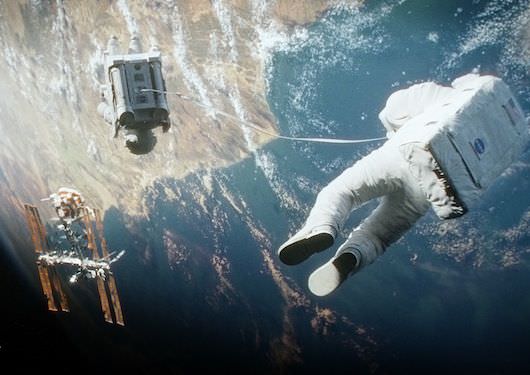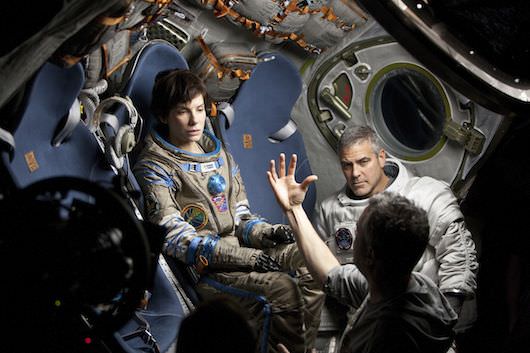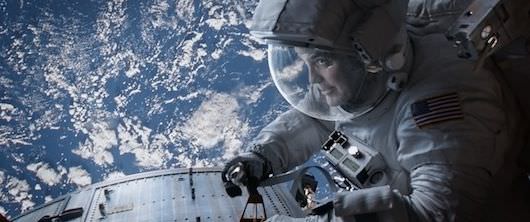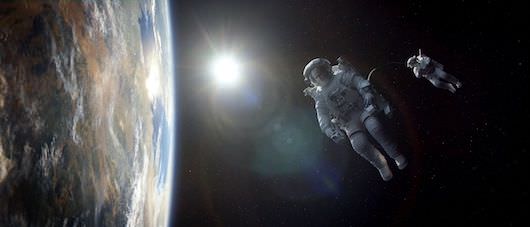One of the Greatest Cinematographers Ever: Gravity‘s Emmanuel Lubezki
He is one of the greatest cinematographers alive, the man directors call when what they want has never been attempted. He has shot films for a slew of legends (Mike Nichols, Tim Burton, Michael Mann, Terrence Malick, Martin Scorsese, the Coen Brothers), but it’s Emmanuel Lubezki's relationship with his childhood friend from Mexico, director Alfonso Cuarón, that’s truly one of the great partnerships in the history of the medium. If this sounds overblown, then you probably haven’t seen their work together, which can now be acclaimed, 22 years after their first feature film together, as one marked by a commitment to making films that are marvels of innovation, technique, and most importantly, visceral emotion.
Lubezki’s (known as ‘Chivo’) last two collaborations with Cuarón required new technology to achieve their goals. Children of Men, which premiered in 2006, stunned the film community (and the too-small number of people who saw the film) with shots that put the viewer into an intense emotional proximity with Clive Owen (Theo). Set in 2027 in a dystopian, sterile world (we mean that literally—a baby hasn’t been born in 18 years), Children of Men delivered one immensely harrowing moment after another. Lubezki’s camera sunk right down into the disorienting terror of an apocalyptic England as it relentlessly followed Theo from café to pub to train and finally into a reconnection with his ex-wife Julian (Julianne Moore), the leader to a revolutionary force known as the Fishes, which bears major secret—they’ve found a young, pregnant African woman, Kee (Clare-Hope Ashitey). Kee is a potential savior.
In a film filled with standout scenes, two have become legends. The first is the uninterrupted one-shot “ambush” of Theo, Julian and Kee’s getaway car, in which Lubezki’s camera moves in, around, and out of the moving car in a spectacularly prolonged and tense five-minute sequence. This scene required trick car seats, a windshield, and a host of brand new technology to achieve. The second is an equally terrifying but even more explosive scene in a war-torn city during which Theo moves from alleyways to bullet-pocked walls as gunfire and ordinance explode all around him as he desperately searches for Kee. At one point, blood splatters on the camera, and by the time Theo has made it into a building (he can hear Kee’s newborn wailing) the scene has at some point been cut (no more blood on the camera), but it’s impossible to tell precisely when.
Reverse Shot, an independent film journal, said this of Lubezki’s role in Children of Men, and his chops overall—and this was in 2006: “Yet Children of Men is as much Lubezki’s accomplishment as it is Cuarón’s; years from now when critics look back on his work here and with Terrence Malick in The New World, Lubezki will be regarded as one of the era’s great film artists."
This statement was valid in 2006 and with the release of Warner Bros. Pictures Gravity today, Lubezki’s place among the pantheon of greatest cinematographers is secure. An astonishing achievement technically, visually, and emotionally, Gravity is the reason you go to the movies. When an accidental explosion and a cloud of debris maroons two astronauts (Sandra Bullock and George Clooney) in space, you begin a cinematic journey that stands as testament to the daring and passion of every filmmaker involved, from Cuarón and Lubezki to their FX wizard Tim Weber to every last member of the cast and crew. Gravity also works as an invigorating argument for the use of 3D. It’s one of the very great theater experiences you will have, this year or any other.
We spoke to Lubezki about what it took to create this masterpiece, the many scary moments on set, and his long, fruitful, and warm relationship with Alfonso Cuarón.
This is the first film you shot entirely digitally—how did this change your process?
I’ve been working with digital cameras for a while, but I’ve never done a fully digital film. When we started doing prep for Gravity and began figuring out how to shoot it, we quickly realized that film was not an option.

Why not?
That had to do with what happens with the film grain in 3D, because the film grain lives in a very specific place in the depth of 3D that just looks weird. It almost looks like a curtain, so we couldn’t use film. And then the other thing we realized is that because of how long the shots are, and how complicated it was going to be for me and Alfonso to be near the actors, we liked that digital cameras and their monitors allowed us to have a very good idea of how the film was going to look and what the actors were doing. We could really watch, with very high detail, their expressions. Also talking to Tim Weber [Gravity’s VFX supervisor] about the fact that we were going to do all the digital compositing, we realized we had to do the movie digitally.
This is not the first time you’ve worked with Alfonso in which the degree of difficulty was, to put it mildly, severe.
Well it’s because when the director has this vision, my job as cinematographer is to try to translate that vision into images, to capture or create these images. There was no equipment around [at the time] that I could rent and there was nothing already built for me, so you put together a team of people you trust, that have the same drive as you, and you start to do tests and create your own gear. Obviously it makes it much harder in the sense that you create this equipment that is custom built and there are no doubles or spare parts, so if something goes wrong it’s just very scary. You also need the support from the studio. They need to know that it’s a very delicate proposition and things could go wrong. So there’s a whole team of people who give you the support you need to have and also the insanity and stubbornness (laughs) and appetite of the director that you work with.
Can you touch upon some of the pieces of technology and equipment that were created to make Gravity possible?
To make this movie we used many different methodologies. For one of them, we invented this LED box that you’ve probably read about, which is basically this very large LED monitor that is folded into a cube. So all the information and images that you input into this monitor lights the actors, and you can input all of the scenes that were pre-visualized to create the movie—all the environments that we had created—and you can input them into this large cube so space itself is moving around the actors.

So it’s not Sandra Bullock spinning around like crazy, it’s your cameras.
Yes, instead of having Sandra turning in 360s and hanging from cables, what’s happening is she’s standing in the middle of this cube and the environment and the lighting is moving around her. The lighting on the movie is very complex—it’s changing all the time from day to night, all the color temperatures are changing and the contrast is changing. There were a lot of subtleties that you can capture with the box, subtleties that make the integration of the virtual cinematography and the live-action much better than ever before.
Can you give us an example?
If you zoom in on Sandra’s eyes, sometimes you can see the earth moving around—things like that would have been almost impossible to do without the box. So we built the box, but that wasn’t it. To be able to shoot inside the box, we had to build a special rig that holds the camera and moves with motion control. So we had people build a very narrow, lightweight but sturdy rig to control the camera. If you imagine the big box of LEDs, it has a gap that is almost a foot and a half or two feet wide, and the camera has to go into the box and make all these moves to make the audience believe that Sandra is turning and turning, but it’s really the camera and the environment in the box that is moving. So we built the box, the rig, and then used a company called Bot & Dolly. These guys are from San Francisco, and they use robots from the automotive industry. They redid all the software for us, so we were able to use these robots to move the cameras and the lights around the actors.It was just a big ballet of gadgets and new technology for the film.
What kind of snafus did you have to deal with?
When we built the box, we had our idea of the box, we did our tests, and we started working on it to see how accurate it was. Then we realized that you could not go into the box because there were so many electromagnetic fields that if you touched it, you would get a shock. So there were a lot of things that were unpredictable happening as we were rushing to shoot the film. A week before Sandra arrived, we were still trying to figure out how we were going to keep her safe in the box so she didn’t get shocks every time she gets in it. There’s a lot of little stories like that that now are funny, but at the time were really, really scary.
That’s a lot of pressure, and it’s not like film sets are notorious for being relaxed environments to begin with.
Once we brought Sandra in, she would start acting in the scene and everything is working, the motion control is working, it’s perfectly in sync, and she would say, ‘You know guys, it’s not feeling right because it’s too short. I need two seconds more here and three seconds more there.’ So we would have to reprogram everything for Sandra to be able to perform the way she wanted and to be able to improvise. It’s very hard to be able to improvise with this kind of equipment, and we had to, little by little, make it that way so the actors could have their space and perform, so Sandra’s emotions could be what they are in the movie.

There was another very interesting problem the first rig we built for George. We started building it a couple of months before we started the shoot, and I suggested to Alfonso he talk to George and ask him if he was going to be comfortable performing at a certain degree—he was not going to be standing up, he was going to be, let’s say, at almost ninety degrees. George said okay, but I didn’t think he knew how complicated and long the shoot was going to be. So when we brought him in we realized in a few seconds that the scene could not be shot like that, because it was so strenuous. We could feel the tension on his body, so we stopped it and had to reprogram it and go back and rethink how to shoot that moment with him. It was a bumpy, a very bumpy, road, but I’m glad we did it.
There are very few director/cinematographer teams working today as well known for a certain aspect of filmmaking as you and Alfonso are, which is that long extended take, or the seamlessly edited take. What it is like actually shooting those scenes?
I’m going to tell you something, the reality is that the movie was so new that when we finished a shot we would get so excited people would scream on set—probably me before anybody else. There were moments when we were shooting and Alfonso said ‘cut’ we would all just jump and scream out of happiness because we’d achieved something that we knew was very special.
In Children of Men, we also had moments like that. When we finished the first shot inside that car [the aforementioned ambush scene], the focus puller started crying. There was so much pressure that, when he realized he had done a great job, he just started crying.
As the cinematographer, you must feel an insane amount of pressure yourself.
You know for me it’s an incredible pressure, but for Alfonso it must be fifty times more because he has to deliver something, and he’s getting notes, people saying you shouldn’t do it in one take, it’s not going to work, why don’t you do it the way everybody else does it? And one thing I want to say is that Alfonso is not doing these shots because he wants to show off, or because they are tour de forces shots of an auteur, or because they are gimmicks. I think he does it from a very honest perspective. It's that he’s doing them because he wants to capture a certain emotion, and he believes—I hate to talk for him because he might not agree with me—but my feeling is he does these shots because it is the only way to capture certain emotions, and it’s the only way to get the audience immersed as deeply as you get immersed in moments like in that scene, or in Gravity. When you feel things are happening in real time and there’s that immediacy with the actors, and the camera is doing all of these elastic shots that are very objective shots that then become subjective shots, and you see what Sandra’s going through, you see it through her eyes, and then you also see objectively from the audience’s point of view, I think all that creates an energy, a tension, and a feeling of being immersed that otherwise you cannot achieve.
And that experience is only heightened now with the use of 3D in Gravity.
[Shooting in 3D] was a decision truly made from an honest filmmaker who is trying to capture emotion in a different way. One thing that I love about working with Alfonso is he’s a true artist. I like that he uses all the tools of filmmaking really well. He could do the movie by himself—he's a great cinematographer, he’s a great sound man, he’s a great actor, so he really uses all the tools. And he uses the tool that I love the most, cinematography, in a way that he’s not using to illustrate text. He uses it to capture emotion and to deliver emotion. I’m very lucky to work with him.
You guys have known each other for so long, is it the trust you guys have from growing up together in Mexico that makes you such a formidable filmmaking partnership?
I’m inside this equation so I truly don’t know, but I met Alfonso many, many years ago. We went as teenagers to the same parties, talked about the same girls, we danced together, and we went to film theaters together. We spent many hours watching what you guys call foreign films in the late 70s and early 80s, and he was always a little bit of a teacher for me. We’re almost on the same frequency–sometimes he doesn’t call me for a year, but when he calls and says, ‘Oh I have this idea for this movie,’ it just happens to be exactly what I would like to be doing. It’s very strange, even though we don’t see each other every day, there is something very close in what we like about film, and art in general.

Featured image: Sandra Bullock as Ryan Stone in Gravity. Courtesy Warner Bros. Pictures



